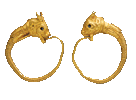Women's Life
Dress and Toilet
Articles

Women´s clothes changed very little over
hundreds of years (not like now!) Clothes were normally made at home
from locally available wool or flax (used to make linen). The two
most commonly worn garments were the chiton or tunic and the
himation or cloak.
The chiton came in two styles. Its earlier Doric
version, preferred by Athenian women until the end of the 6th century
BC, was called the peplos and was made of wool. Cut into a
simple rectangle measuring half again the height of the person
wearing it, it was folded over, wrapped around the body, and pinned
at the shoulders and side. It was sleeveless, with large arm
openings. Expensive versions were decorated with elaborate woven
figures or designs.
The Ionian chiton was made of linen that fell into
more elaborate vertical folds than its heavier wool counterpart. The
sides were sewn up to create a long cylinder which was then pulled in
by a girdle or cord at the waist or just below the breasts. Short
sleeves were added to the sides.
|

|
Italic Low-Footed Red Figure Bowl with High
Handles
4th century BC
On loan, Philadelphia Museum of Art
L-64-23 detail
The most common toilet article appearing on vases is the
mirror, usually made of polished silver or bronze. These and
a wide variety of cosmetic implements are often excavated in
tombs, sanctuaries dedicated to female divinities, and in
the domestic quarters of ancient towns.
Photo courtesy Mediterranean Section, Univ. of Pennsylvania
Museum
(large version)
|
|

|
Terracotta Figurine
Early 3rd century BC
MS 5679
Standing clothed female figure of possibly Corinthian
manufacture, wearing a himation over a floor-length chiton.
The himation was a rectangle of wool or linen, often drawn
away from one shoulder. The figure´s earrings are well
preserved. Traces of white slip cover most of the figure,
and rusty red survives in the hair.
H. 20.7; W. 7.6; Th. 5.0 cm. Photo courtesy Public
Information Office, Univ. of Pennsylvania Museum (large
version)
|




The Ancient Greek World Index

